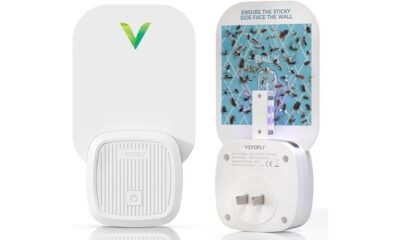Architecture Home Styles
What Does Classic Mean in Interior Design Styles?
Hone your understanding of classic interior design styles to discover their enduring appeal and timeless elegance.
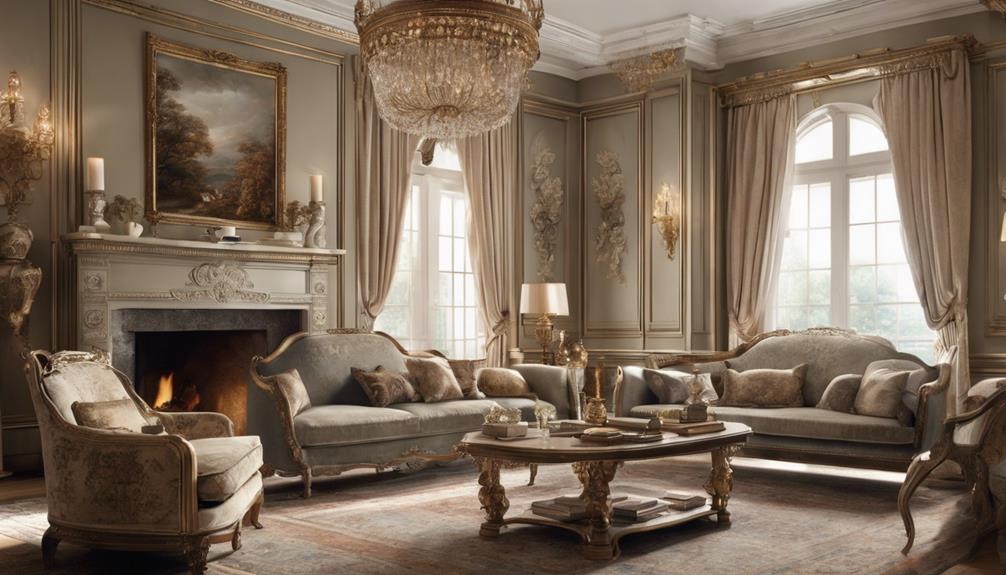
In interior design, the term 'classic' conjures up images of elegance, sophistication, and enduring charm. But what does it truly mean in the realm of design styles?
Classic interior design encompasses a rich tapestry of historical influences, architectural details, and refined aesthetics that stand the test of time. While many may think of classic as synonymous with outdated or stuffy, a deeper exploration reveals a nuanced and timeless allure that continues to captivate contemporary designers and homeowners alike.
Key Takeaways
- Classic interior design features opulent materials like oak and marble, emphasizing luxury and grandeur.
- Symmetry, elegant color palettes, and rich lighting contribute to a refined and sophisticated ambiance.
- Classic design exudes timeless elegance through noble materials, soft color palettes, and disciplined decor choices.
- Incorporating classic style at home involves balancing traditional elements with modern innovations for a sophisticated aesthetic.
Classic Interior Design Vs. Traditional Style
When delving into the realm of interior design, distinguishing between classic interior design and traditional style can unveil a world of contrasting aesthetics and atmospheres. Classic interior design exudes a sense of luxury and grandeur through the use of opulent designs and luxury materials like oak, mahogany, and marble. The color palette is carefully chosen to create a symmetrical and elegant look that emphasizes discipline and special combinations for a refined ambiance. Lighting options in classic interiors tend to be rich and opulent, adding to the overall luxurious feel of the space.
On the other hand, traditional style focuses on creating a cozy atmosphere with solid wood furniture and lively color patterns. While classic interior design leans towards a more formal and grandiose feel, traditional style offers elegance through affordability and functional elements. The lighting in traditional style spaces is warmer and softer, contributing to a comfortable and welcoming environment. Mixing modern elements with either classic interior design or traditional style can bring a fresh and innovative twist to the overall aesthetic.
Key Features of Classic Interior Design
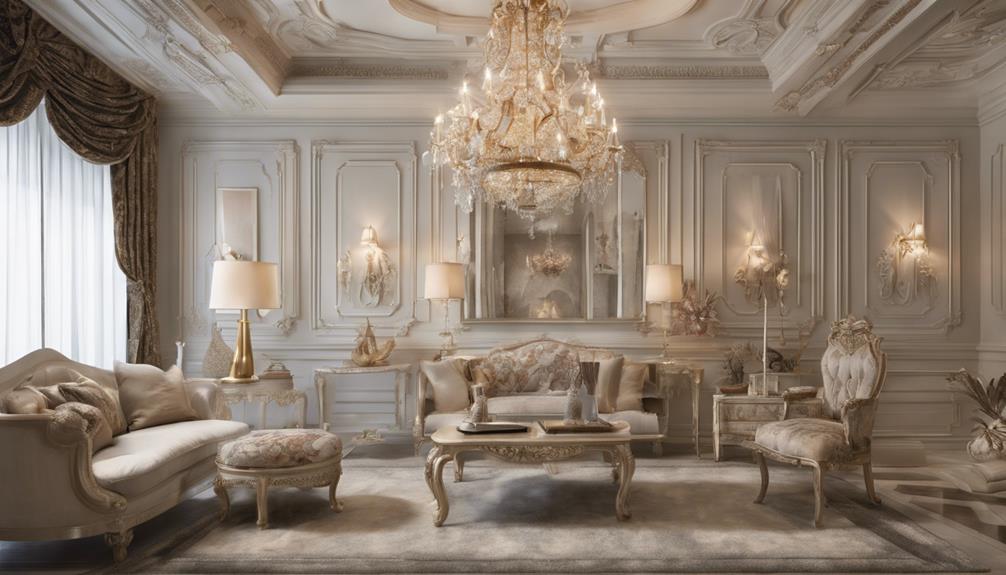
Symmetry, discipline, and a unique color combination intricately blend in classic interior design to craft an ambiance of refined sophistication and elegance. In classic interior design, traditional elements like noble materials such as wood, marble, and metals are often utilized to evoke luxury and sophistication. The furniture in classic interiors typically features hand-woven patterned carpets, valuable metal and wooden decorations, and opulent curtains made of heavy velvet fabric, all contributing to a sense of grandeur.
Lighting is a key feature in classic interior design, with wooden and crystal chandeliers being popular choices to enhance the overall elegance of the space. Additionally, wall art plays a significant role in classic interiors, often showcasing classical paintings, Persian miniature paintings, and luxurious wall rugs that add depth and character to the decor. These elements come together to create a timeless and sophisticated atmosphere that's characteristic of classic interior design.
Incorporating Classic Style in Your Home
To infuse your home with the timeless elegance of classic interior design, consider incorporating traditional elements like noble materials and opulent finishes. Traditional furniture with intricate details, warm fabrics, and classic lines can create a cozy and inviting atmosphere in your living room. When blending traditional and modern elements, aim for a harmonious balance that showcases the best of both worlds. By combining classic style with modern touches, you can create a space that feels both luxurious and up-to-date.
Lighting solutions are essential in classic interior design. From ornate chandeliers to softer ambient lighting, the right lighting can enhance the overall aesthetic of your home. To achieve a modern take on classic design, consider incorporating contemporary lighting fixtures that complement the traditional elements in your space.
Incorporating opulent finishes like gold accents or intricate moldings can add a touch of luxury to your home while maintaining the classic style. These finishing touches elevate the overall look of your space and create a truly sophisticated atmosphere.
Timeless Elegance in Classic Design
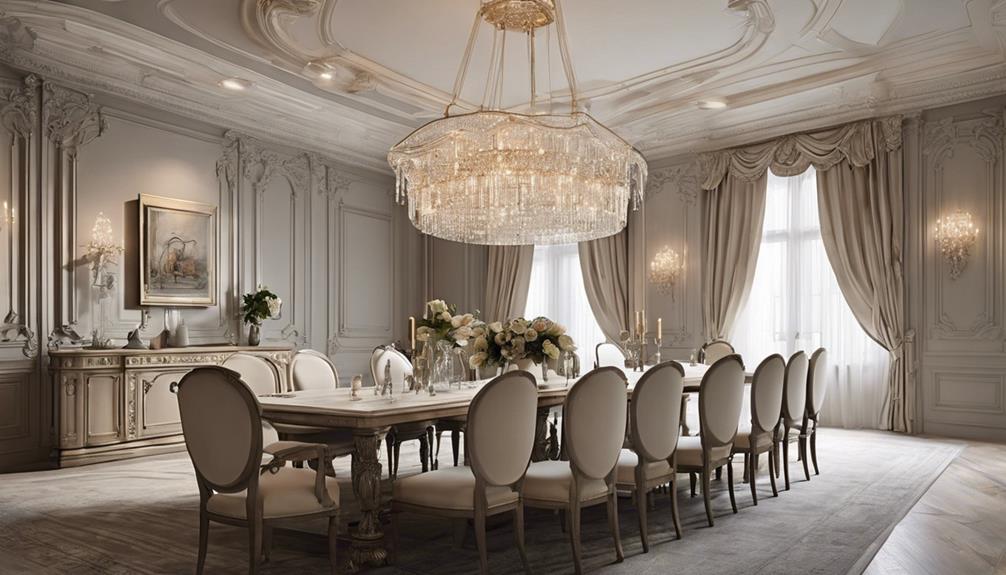
Crafting a space exuding timeless elegance in classic design requires a meticulous selection of noble materials and refined aesthetics to achieve a sense of luxury and sophistication. The classic interior design style thrives on traditional elements, emphasizing harmony and balance through symmetrical arrangements and classic furnishings.
Noble materials such as oak, mahogany, and marble play a vital role in conveying luxury and prestige within the space. Soft color palettes, including cream, beige, and muted tones, are commonly used to create a warm and inviting ambiance that complements the overall design.
In classic design, disciplined decor choices and special color combinations are pivotal in exuding a sense of royalty and luxury, elevating the space to a level of sophistication that stands the test of time. By incorporating these elements thoughtfully, one can achieve a space that radiates timeless elegance and captures the essence of classic design principles.
Classic Design Elements and Tips
Emphasizing a harmonious blend of traditional elegance and refined aesthetics, classic interior design incorporates a meticulous selection of noble materials and disciplined decor choices to create a space exuding luxury and sophistication. In the realm of classic design elements and tips, consider the following:
- Symmetry and Discipline: Essential for a refined look, classic interiors often feature symmetrical arrangements that exude a sense of balance and order.
- Wooden Decorations: Wooden items add warmth and a sense of timelessness to classic spaces, bringing in a touch of nature and sophistication.
- Velvet Curtains: Heavy velvet curtains in rich, deep colors add a luxurious feel to the room while also providing insulation and enhancing the classic aesthetic.
- Hand-Woven Carpets: Intricately patterned hand-woven carpets bring texture and visual interest to classic interiors, adding a touch of artistry to the space.
- Crystal Chandeliers: Lighting is key in classic design, and crystal chandeliers offer a dazzling focal point that exudes opulence and elegance, elevating the overall ambiance of the room.
Frequently Asked Questions
What Is Classic Style in Interior Design?
Classic style in interior design embodies timeless elegance, symmetry, and a harmonious color palette. It exudes sophistication through wooden furniture, luxurious fabrics, and intricate decorative elements.
Natural materials like wood and marble are staples, complemented by ornate lighting fixtures and decorative accents. The classic design aesthetic creates a refined and inviting atmosphere that pays homage to traditional craftsmanship and historical influences.
What Is the Difference Between Classic and Traditional Interior Design?
When comparing classic and traditional interior design, we notice distinct elements that set them apart. Classic design embodies opulence and grandeur, featuring intricate details and gilded finishes.
In contrast, traditional design offers elegance with simplicity, warmer hues, and affordability. These styles diverge in their approach to color palettes, materials, and lighting choices, catering to different tastes and preferences.
Classic exudes luxury, while traditional embraces coziness and moderation.
What Is the Difference Between Modern and Classic Interior Design?
In modern interior design, we embrace simplicity, functionality, and contemporary aesthetics, while classic design emphasizes symmetry, discipline, and refined color combinations. Modern spaces often feature bold color accents and sleek, minimalistic furniture, while classic interiors lean towards softer, warmer color palettes and elegant, ornate furnishings.
These differences in aesthetics, materials, and design philosophy cater to various tastes and preferences, showcasing the dynamic range of interior design styles available.
What Is a Classic Style House?
We appreciate the inquiry about classic style houses. These homes embody timeless elegance through symmetrical layouts and luxurious details.
Special color palettes and intricate wooden elements create a sense of opulence and grandeur. Valuable metal accents and ornate decorations further enhance the classic style's sophistication.
Heavy velvet curtains and hand-woven carpets add a touch of regal charm. Classic style houses truly exude a sense of refined beauty and grace.
Conclusion
In conclusion, classic interior design is like a fine wine – it only gets better with time. With its timeless elegance, luxurious materials, and attention to detail, classic style brings a sense of grandeur and sophistication to any space.
As they say, 'old is gold', and in the world of interior design, classic never goes out of style. So, whether you're a fan of ornate details or symmetrical arrangements, embracing classic design will always elevate your home to a new level of elegance.
- About the Author
- Latest Posts
Introducing Ron, the home decor aficionado at ByRetreat, whose passion for creating beautiful and inviting spaces is at the heart of his work. With his deep knowledge of home decor and his innate sense of style, Ron brings a wealth of expertise and a keen eye for detail to the ByRetreat team.
Ron’s love for home decor goes beyond aesthetics; he understands that our surroundings play a significant role in our overall well-being and productivity. With this in mind, Ron is dedicated to transforming remote workspaces into havens of comfort, functionality, and beauty.
Architecture Home Styles
10 Surprising Reasons People Keep Their Houses Dark
Yearning for a deeper understanding of why some choose shadows over light in their homes? Discover the unexpected motivations behind this intriguing preference.

Have you ever wondered why some people prefer to live in what seems like perpetual twilight within their homes? It's a curious phenomenon that sparks intrigue and prompts us to ponder the unexpected motivations behind this choice.
As we explore the multifaceted reasons individuals keep their living spaces dimly lit, we uncover a myriad of surprising factors that go beyond mere lighting preferences. From psychological comfort to unexpected health benefits, the desire for darker surroundings reveals a complex interplay of personal inclinations and practical considerations that might just change your perspective on this seemingly simple decision.
Key Takeaways
- Dark rooms foster psychological comfort and tranquility amidst chaos and overstimulation.
- Opting for natural light in dark spaces conserves energy and reduces electricity bills.
- Dark interiors provide privacy, security, and solace for those seeking refuge from unwanted eyes.
- Creating a stylish and inviting atmosphere, dark color schemes enhance aesthetics and promote better sleep quality.
Psychological Comfort
Amidst the hustle and bustle of modern life, many individuals find solace and tranquility in the embrace of dark spaces, seeking emotional comfort and a retreat from the relentless demands of the outside world. When we keep the blinds open, allowing just a hint of natural light to filter through, we create a cozy sanctuary where we can truly unwind. By incorporating natural materials like wood and stone into our dark interiors, we connect with the earth's grounding energy, fostering a sense of peace within ourselves.
Being able to see without the harsh glare of artificial lights can be a liberating experience, allowing us to relax and rejuvenate. The subtle play of light and shadows in a dark room creates a soothing atmosphere that promotes psychological comfort. It's in these moments of gentle darkness that we find a refuge from the overstimulation of the day, embracing a more serene state of mind. Dark spaces offer a canvas for our thoughts to wander freely, unencumbered by the distractions of a brightly lit world.
Energy Conservation
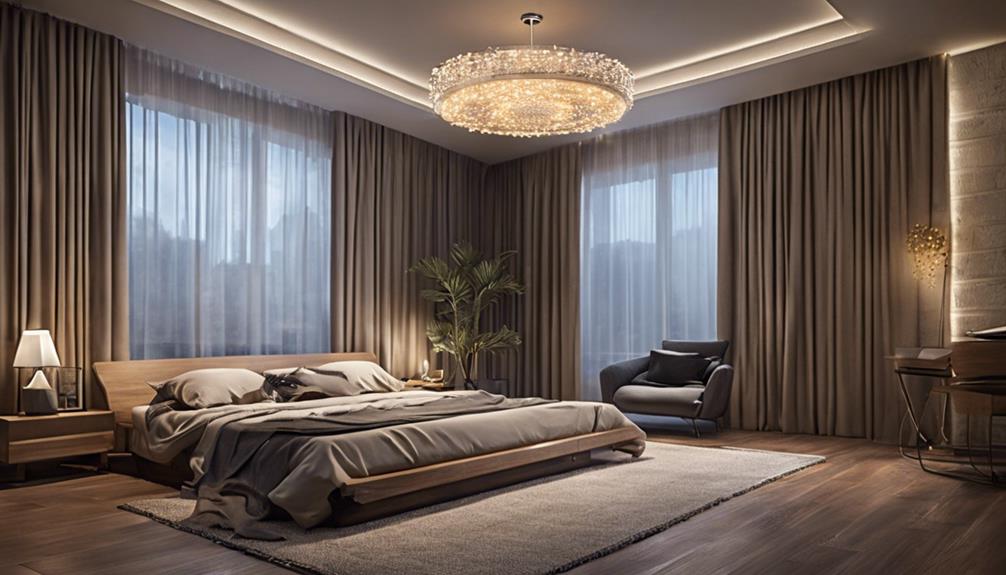
In the realm of household management, a significant motivation for maintaining dimly lit interiors is the emphasis on energy conservation. By reducing lighting usage, we not only lower electricity bills but also decrease our carbon footprint. Here are some key points to consider:
- Using natural light: Opting for natural light during the day instead of relying solely on artificial lighting is a sustainable practice that can significantly reduce energy consumption.
- Opting for energy-efficient lighting: Choosing energy-efficient options like LED bulbs is a smart move for those looking to conserve energy and cut costs in the long run.
- Implementing smart lighting systems: Installing smart lighting systems that adjust brightness based on natural light levels not only enhances convenience but also contributes to energy conservation efforts.
- Keeping curtains drawn: Drawing curtains during the day to let in natural light while minimizing heat gain can help regulate indoor temperatures and reduce the need for artificial lighting.
Privacy Concerns
With a focus on conserving energy through lighting adjustments, the conversation seamlessly shifts to the realm of privacy concerns influencing individuals to keep their houses dark. Fear of break-ins and intrusions can drive us to opt for darker living spaces, seeking that added layer of privacy when we come home. It's not just about energy savings; privacy concerns, such as avoiding peeping Toms or unwanted eyes, play a significant role in our decision to keep curtains drawn and lights low.
For some of us who've endured past traumatic experiences involving privacy violations, darker environments may provide a sense of security and comfort. Balancing the need for natural light with privacy can be achieved by using privacy shears during the day, allowing us to control the level of exposure while maintaining our desired sense of seclusion.
Ultimately, personal preference for privacy is a compelling factor in choosing to live in darker settings, where we feel safe and shielded from external intrusions.
Aesthetic Appeal
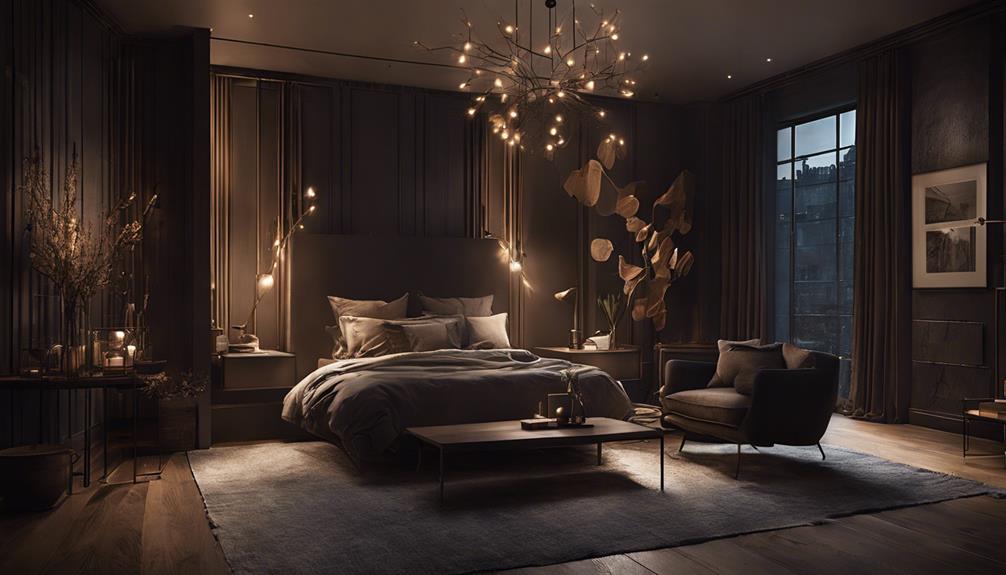
Exploring the captivating allure of dark interiors reveals a realm where visual aesthetics intertwine with a sense of cozy sophistication and elegance. Dark rooms possess an undeniable charm that goes beyond mere color schemes; they offer a canvas for creativity and individuality. Here's why dark interiors can be so appealing:
- Dramatic Contrast: Dark color schemes allow for striking contrasts when paired with light accents, creating a visually dynamic atmosphere that captivates the eye.
- Sophisticated Elegance: The use of dark hues can evoke a feeling of luxury and refinement, elevating the overall ambiance of a space.
- Cozy Atmosphere: Dark rooms have a unique ability to create a warm and inviting atmosphere, perfect for unwinding after a long day.
- Enhanced Architectural Features: By playing with light and shadow, dark interiors can accentuate specific architectural elements, adding depth and character to a room.
Incorporating these elements into interior design can transform a space into a haven of style and sophistication, appealing to those who seek liberation through unique and aesthetically pleasing environments.
Better Sleep Quality
Delving into the realm of dark interiors unveils a key element crucial for enhancing sleep quality: the absence of bright light. Exposure to bright light before bedtime can disrupt our body's natural sleep-wake cycle, impacting the production of melatonin, which is essential for quality sleep. By creating a dark environment, we signal our brains to produce melatonin, helping us fall asleep faster and enjoy a more restful slumber.
Blocking out light sources in the bedroom can promote deeper sleep, leading to better overall sleep quality and duration. Studies have shown that dark rooms can significantly improve our sleep quality, allowing us to wake up feeling more refreshed and rejuvenated. Whether it's investing in blackout curtains, switching off bright overhead lights, or simply embracing the tranquility of darkness, prioritizing a dark environment can be a game-changer for those seeking liberation from restless nights and aiming for a peaceful slumber.
Protecting Artwork

We all know how sunlight can be a double-edged sword when it comes to preserving our beloved artwork. Those vibrant colors we cherish can fade away in the harsh light.
Artwork Light Sensitivity
To safeguard delicate artwork from the damaging effects of sunlight, many homeowners prefer to keep their houses dimly lit. This practice helps prevent colors from fading and maintains the quality of paintings, photographs, and other valuable pieces. Art collectors often opt for controlled lighting to preserve the integrity of their collections. By keeping rooms dark, the vibrancy and longevity of the artwork on display are prolonged, ensuring that each piece remains as captivating as the day it was acquired.
- Dim lighting protects artwork from fading
- Controlled lighting preserves the integrity of valuable pieces
- Dark rooms maintain the vibrancy of displayed artwork
- Prevents sunlight damage to paintings, photographs, and other pieces
UV Damage Prevention
Dim lighting in homes plays a crucial role in safeguarding valuable artwork by significantly reducing the risk of UV damage. UV radiation can cause colors to fade and materials to deteriorate over time, making darkness a protective measure. Art collectors and museums often keep their spaces dark to preserve the integrity of paintings, sculptures, and other art pieces. Direct sunlight can be particularly damaging to artwork, prompting the need for controlled lighting environments. Maintaining a dark setting can prolong the lifespan and beauty of art collections by minimizing UV-related risks.
| UV Damage Prevention | Importance | Effects |
|---|---|---|
| Reduced Exposure | Protects Artwork | Prevents Fading of Colors |
| Controlled Lighting | Preserves Integrity | Minimizes Deterioration of Materials |
| Art Collector Choice | Extends Art Lifespan | Safeguards Against UV Risks |
Color Preservation Techniques
Protecting artwork's vibrant colors requires implementing effective color preservation techniques in dark environments to shield against UV damage and maintain long-lasting artistic integrity. To keep your artwork looking its best, consider the following tips:
- Utilize UV-Filtering Glass: Invest in UV-filtering glass to protect artwork from harmful sunlight exposure.
- Rotate Artwork: Regularly rotate your art pieces to ensure even exposure and prevent color fading in specific areas.
- Control Humidity Levels: Maintain stable humidity levels to prevent moisture damage that can affect color vibrancy.
- Use Conservation-Grade Materials: Opt for conservation-grade materials when framing artwork to provide an extra layer of protection against color deterioration.
Minimizing Glare
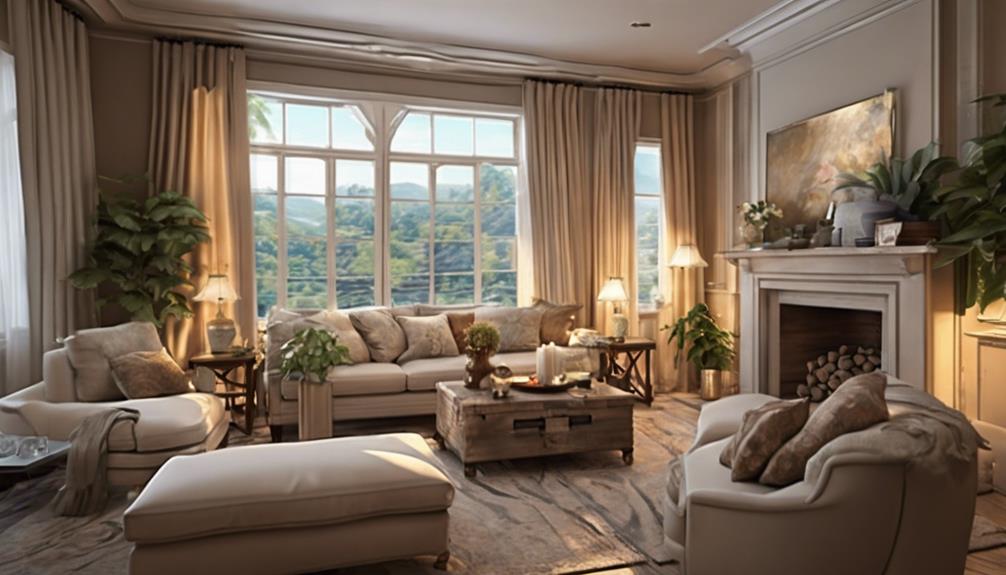
When seeking to create a comfortable and visually soothing home environment, minimizing glare becomes a crucial consideration. Glare from bright sunlight can cause eye strain and discomfort, making it essential to keep the house dark to reduce these effects. Homes with large windows or abundant natural light are especially prone to glare issues, highlighting the importance of managing light levels effectively. By embracing dark interiors, harsh reflections can be minimized, creating a more pleasant ambiance while improving visibility within the space. Dark rooms not only enhance the overall aesthetic but also help individuals focus on tasks without being distracted by excessive lighting.
| Benefits of Minimizing Glare |
|---|
| Reduces eye strain |
| Enhances visual comfort |
| Improves visibility |
| Creates a soothing ambiance |
| Minimizes distractions |
Cooling Effects
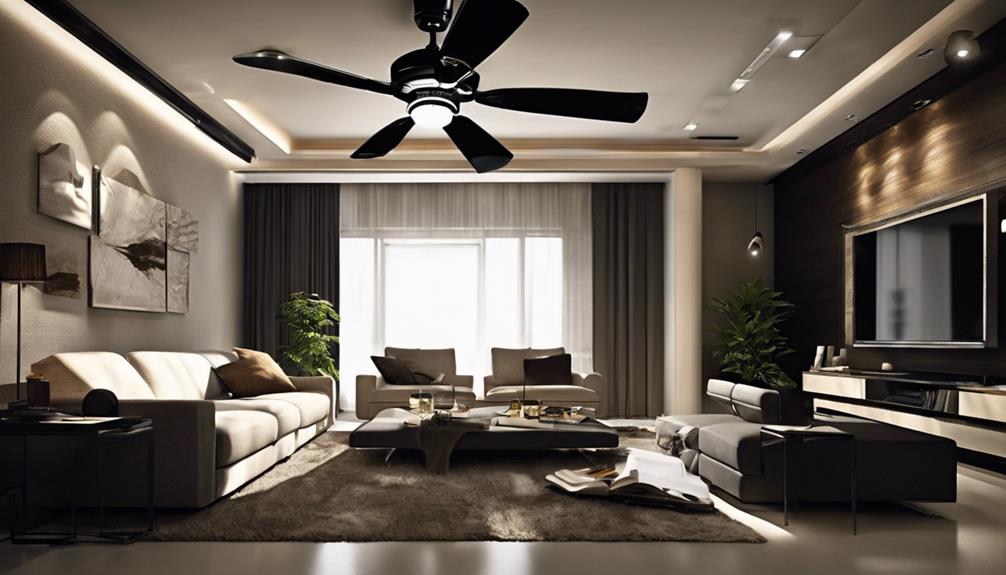
Staying cool in our homes can be effortlessly achieved by incorporating dark interiors that not only enhance aesthetic appeal but also help in reducing the temperature through various design elements. Dark color schemes play a crucial role in creating a comfortable environment during hot weather. Here are some ways dark interiors contribute to cooling effects:
- Less Sunlight Absorption: Dark interiors absorb less sunlight, preventing excessive heat buildup.
- Heat Blockage: Choosing dark curtains or blinds can effectively block out excess heat from entering the house.
- Reduced Light Reflection: Dark walls and decor reduce the reflection of light, helping to keep rooms cooler.
- Cooling Elements: Opting for dark furniture and flooring adds to the overall cooling effect in the house.
Security Purposes

Ensuring the safety of our homes, some individuals choose to keep their houses dark for security purposes. By maintaining a dimly lit exterior, they aim to deter potential intruders and protect their property. Dark houses can give the illusion that nobody is home, reducing the risk of break-ins. Drawing curtains further prevents outsiders from peeking in and spotting valuable items within. This sense of privacy also conceals the interior layout of the home from prying eyes, adding an extra layer of security.
To strike a balance between privacy and visibility, security experts recommend thoughtful lighting choices that enhance safety without compromising on comfort. Below is a table summarizing some key considerations when using darkness as a security measure:
| Security Lighting Tips | Description | Benefits |
|---|---|---|
| Use motion-sensor lights | Activated by movement, these lights startle intruders and alert homeowners to potential threats. | Enhanced security |
| Install timer-controlled lights | Simulate occupancy by setting lights to turn on and off at specific times, giving the appearance of someone being home. | Deterrence of burglars |
| Opt for smart lighting systems | Allow remote control of lights through smartphones, enabling homeowners to adjust settings from anywhere. | Convenience and customization of security measures |
Enhancing Mood
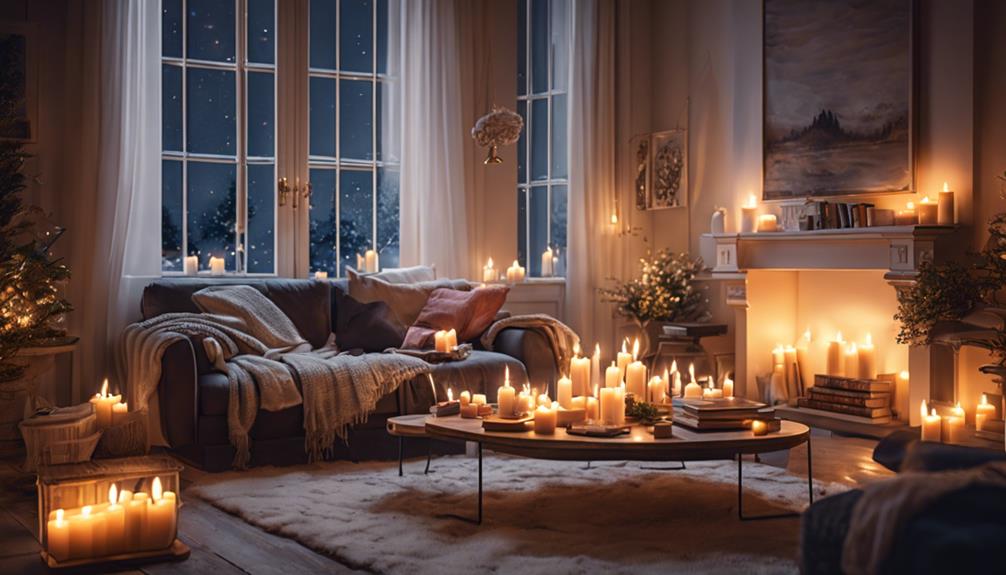
Enhancing the ambiance of a space through dim lighting can significantly impact our mood and emotional well-being. While some may find it unconventional, there are surprising reasons individuals choose to keep their houses dark. Here are a few insights into how dim lighting can enhance mood:
- Comfort and Relaxation: Dark environments have the power to evoke feelings of comfort and relaxation, creating a safe haven within the home.
- Solace and Tranquility: For many, dimly lit spaces offer solace and tranquility, contributing to an improved emotional state and overall well-being.
- Coziness and Security: The coziness and security that dark interiors provide can positively influence mood, making one feel more at ease and content.
- Soothing Ambiance: Dark colors and dim lighting can work together to create a soothing ambiance, promoting a sense of calmness and serenity in the home.
These factors illustrate how personal preferences for low light levels can impact our emotional state in a positive way, allowing us to curate spaces that resonate with our inner selves.
Frequently Asked Questions
Why Do People Keep Their Houses Dark?
We keep our houses dark for various reasons. Light sensitivity, privacy concerns, and a desire for coziness all play a role. Dark environments can provide comfort and security, especially for those dealing with depression.
However, transitioning to a brighter setting could boost mood and well-being. Our living spaces reflect our needs and preferences, whether it's about creating a sanctuary or maintaining a sense of safety and calm.
Why Do I Like My House to Be Dark?
We like our house dark for various reasons. It's a sanctuary, offering comfort and peace. Dark rooms create a cozy atmosphere that helps us unwind and relax.
Our preference for dim lighting is also tied to emotional well-being. Solitude and tranquility are essential for us to recharge and find serenity. The soothing effect of darkness on our mood is undeniable, making our home a haven of calm and quiet.
Why Do Some People Prefer Dark Rooms?
We prefer dark rooms for various reasons. Some find solace in darkness, offering comfort amidst depression. Others seek privacy by keeping curtains drawn, creating a sense of seclusion.
Fear of break-ins drives some to avoid drawing attention to valuables by maintaining a dark home. Migraine sufferers also appreciate the relief from bright lights.
These diverse preferences show how darkness can cater to personal needs and well-being.
Why Do I Prefer Living in the Dark?
We choose to dwell in darkness for reasons that bring us comfort and peace. The dimly lit spaces we inhabit offer solace and relief from the harshness of bright light. Our preference for the shadows stems from a deep desire for emotional tranquility and well-being.
In the dark, we find a haven where our minds can rest and our spirits can thrive. It's in the shadows that we find our true light.
Conclusion
In conclusion, it's fascinating to consider the myriad reasons why people choose to keep their houses dark. Did you know that according to a recent survey, 1 in 5 individuals prefer a dimly lit living space to promote relaxation and create a cozy ambiance?
From psychological comfort to energy conservation, the decision to maintain a dark home is as diverse as the individuals who make it.
Embrace the beauty of darkness and discover the surprising benefits it can offer.
- About the Author
- Latest Posts
Introducing Ron, the home decor aficionado at ByRetreat, whose passion for creating beautiful and inviting spaces is at the heart of his work. With his deep knowledge of home decor and his innate sense of style, Ron brings a wealth of expertise and a keen eye for detail to the ByRetreat team.
Ron’s love for home decor goes beyond aesthetics; he understands that our surroundings play a significant role in our overall well-being and productivity. With this in mind, Ron is dedicated to transforming remote workspaces into havens of comfort, functionality, and beauty.
Architecture Home Styles
Maximizing Efficiency: Discovering the Most Efficient Shape for Your House
Get ready to explore the secrets of efficiency in house design, uncovering the perfect shape that harmonizes with nature and optimizes functionality.

When envisioning the most efficient shape for your house, imagine a structure seamlessly blending with its surroundings, harnessing nature's elements to enhance functionality.
Exploring how different shapes can optimize energy usage and space utilization opens doors to innovative possibilities.
By diving into the intricacies of design and functionality, one can uncover the key to a harmonious living space that not only adapts to your needs but also operates in harmony with the environment.
Let's unravel the mysteries of efficient house shapes and unlock the potential for a home that transcends mere shelter.
Key Takeaways
- Efficient house shapes optimize energy use and enhance comfort.
- Strategic design maximizes natural light and ventilation for a healthier environment.
- Energy consumption reduced through smart layout and sustainable lifestyle choices.
- Space optimization and functionality drive efficiency in house shapes.
Benefits of Efficient House Shapes
When designing a home, the benefits of choosing an efficient house shape are numerous and impactful on energy consumption and overall comfort levels. Efficiency is key in reducing energy consumption and promoting sustainable living practices. A well-thought-out house shape can significantly lower utility bills by optimizing natural lighting and ventilation, thus decreasing the need for artificial heating or cooling. By minimizing heat loss or gain, the right house shape enhances indoor comfort levels, creating a more pleasant living environment. Additionally, certain house shapes can improve energy efficiency, ultimately reducing the carbon footprint associated with household operation.
The orientation and layout of a house shape play a crucial role in maximizing solar gain for passive heating benefits. By harnessing natural resources effectively, an efficient house shape contributes to sustainable living practices and environmental conservation. Choosing a design that prioritizes efficiency isn't only beneficial for personal comfort and energy savings but also for the planet as a whole.
Impact of Natural Light and Ventilation
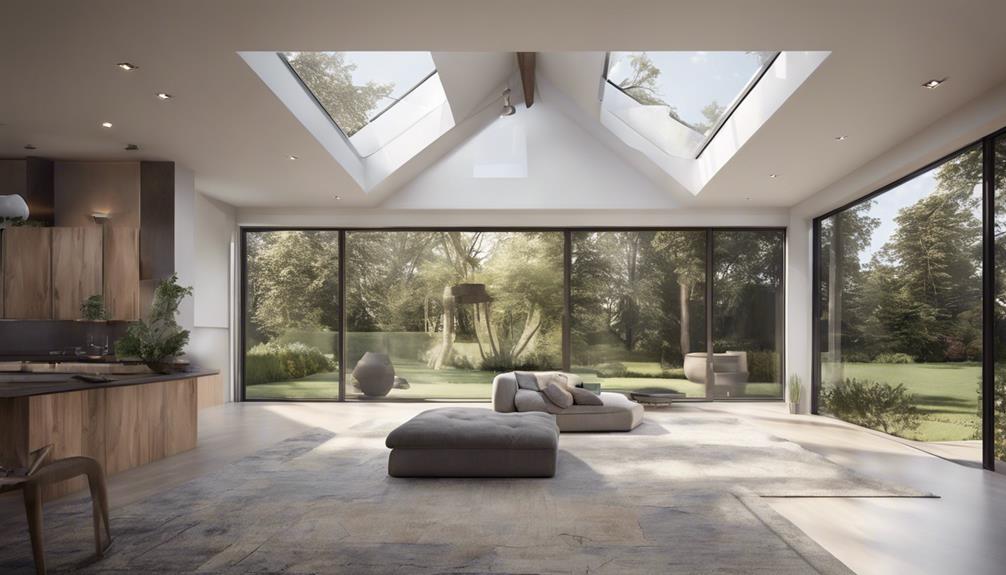
Efficient house shapes not only impact energy consumption and comfort levels but also play a crucial role in maximizing natural light and ventilation for optimal living conditions. When designing a house, our team members collaborate to delegate tasks effectively, ensuring that natural light and ventilation are prioritized. By strategically placing windows and skylights, we can harness natural light to reduce the need for artificial lighting, promoting energy efficiency. Additionally, incorporating cross-ventilation design with windows on opposite walls enhances airflow, lessening the reliance on mechanical ventilation systems. To maintain a balance between daylighting and glare prevention, our team integrates shading elements like overhangs or blinds into the design. Studies support that exposure to natural light not only improves mood and productivity but also enhances overall health. Below is a table highlighting the key considerations for optimizing natural light and ventilation in house design:
| Consideration | Description | Importance |
|---|---|---|
| Window Placement | Strategic positioning to maximize natural light intake and airflow. | High |
| Cross-Ventilation Design | Utilizing windows on opposite walls for effective air circulation. | Medium |
| Shading Elements Integration | Incorporating overhangs or blinds to control natural light and prevent glare. | High |
Energy Consumption Reduction Strategies
Implementing energy-efficient strategies such as upgrading appliances, improving insulation, and utilizing programmable thermostats can significantly reduce household energy consumption. When striving to enhance energy efficiency, consider the following strategies:
- Upgrade to Energy-Efficient Appliances: Investing in energy-efficient appliances can lead to savings of up to 30% on energy consumption, reducing both environmental impact and utility costs.
- Improve Insulation and Sealing: Enhancing insulation and sealing in your home can decrease energy loss by 20%, resulting in substantial savings on heating and cooling expenses over time.
- Utilize Programmable Thermostats: By using programmable thermostats, you can save approximately 10% on annual heating and cooling bills, optimizing your home's energy usage based on your work environment and daily time blocks.
- Install Energy-Efficient Windows: Installing energy-efficient windows can lower energy usage for heating and cooling by up to 25%, contributing to a more sustainable and cost-effective living space while helping you stay focused and productive.
Layouts for Maximizing Efficiency
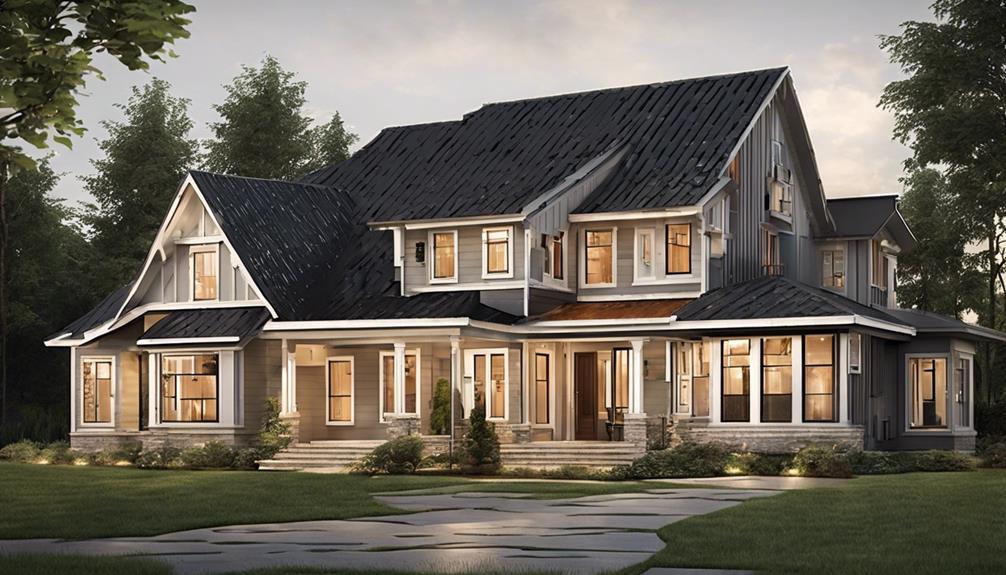
To optimize the efficiency of your home, consider incorporating layouts that maximize space utilization and enhance functionality. Open floor plans and minimal corridors are optimal choices as they enhance spatial efficiency.
Multifunctional furniture and storage solutions are key in maximizing space utilization within house layouts. When designing, prioritize natural light sources and ventilation systems to reduce energy consumption and improve indoor air quality.
Efficient layouts should prioritize traffic flow, minimizing unnecessary detours between rooms. Strategic placement of rooms, such as positioning kitchens near dining areas, streamlines daily activities and enhances convenience.
During the design process, engaging in team meetings to discuss layout options can provide valuable insights and perspectives. Creating detailed to-do lists can help stay organized and ensure all aspects of layout efficiency are considered.
Additionally, engaging in exercises like room mock-ups or walkthroughs can help visualize the flow and functionality of the space. By incorporating these strategies, you can create a home layout that maximizes efficiency and enhances daily living experiences.
Sustainable Lifestyle Design Options
Exploring sustainable lifestyle design options opens up a world of possibilities for creating eco-friendly and energy-efficient homes. When considering the design of a sustainable house, incorporating elements such as passive solar design, energy-efficient appliances, and eco-friendly building materials can significantly enhance its overall sustainability. To further boost eco-friendliness, additional features like green roofs, rainwater harvesting systems, and solar panels can be integrated into the design to minimize the environmental impact of the house.
- Passive Solar Design: Utilizing the sun's energy for heating and lighting purposes can help reduce reliance on traditional heating and lighting systems.
- Energy-Efficient Appliances: Opting for appliances with high energy efficiency ratings can lower electricity consumption and minimize the house's carbon footprint.
- Eco-Friendly Building Materials: Using sustainable and recyclable materials in construction not only reduces waste but also promotes environmental conservation.
- Smart Home Technology: Incorporating smart devices for energy management can further optimize energy usage and enhance the overall efficiency of the house.
Frequently Asked Questions
What Does Maximizing Efficiency Mean?
Maximizing efficiency means optimizing resources to achieve the best possible outcome. It involves streamlining processes, reducing waste, and enhancing productivity. By focusing on efficiency, we can accomplish more with less, saving time and resources.
How Do You Maximize Efficiency?
To maximize efficiency, we embrace smart design choices like space-saving furniture and energy-efficient appliances. By creating multi-functional rooms with ample natural light and ventilation, we streamline our living spaces for optimal functionality and well-being.
How Do You Max Out Efficiency?
When we max out efficiency, we focus on smart design, multi-functional furniture, energy-efficient appliances, and automation. By incorporating these elements, we create a space that optimizes usage, reduces costs, and streamlines daily tasks for a more efficient lifestyle.
How Did You Ensure That Efficiency Would Be Maximised?
We ensured efficiency by strategically designing with a rectangular shape, optimizing natural light through well-placed windows and doors. Smart technology and centralized utilities further streamlined maintenance. Insulation and energy-efficient appliances minimized costs. Our approach maximized functionality and comfort.
Conclusion
In conclusion, by choosing the most efficient shape for your house, you can transform your living space into a powerhouse of energy savings and eco-friendly living.
With the right design choices and sustainable practices, your home can become a beacon of efficiency that not only saves you money but also helps protect the environment.
So, why settle for anything less when you can have a home that's truly optimized for maximum efficiency?
- About the Author
- Latest Posts
Introducing Ron, the home decor aficionado at ByRetreat, whose passion for creating beautiful and inviting spaces is at the heart of his work. With his deep knowledge of home decor and his innate sense of style, Ron brings a wealth of expertise and a keen eye for detail to the ByRetreat team.
Ron’s love for home decor goes beyond aesthetics; he understands that our surroundings play a significant role in our overall well-being and productivity. With this in mind, Ron is dedicated to transforming remote workspaces into havens of comfort, functionality, and beauty.
Architecture Home Styles
What Elements Define Tropical Design Style?
Curious about what elements define tropical design style? Explore how patterns, textures, and colors come together to create a paradise in your home.
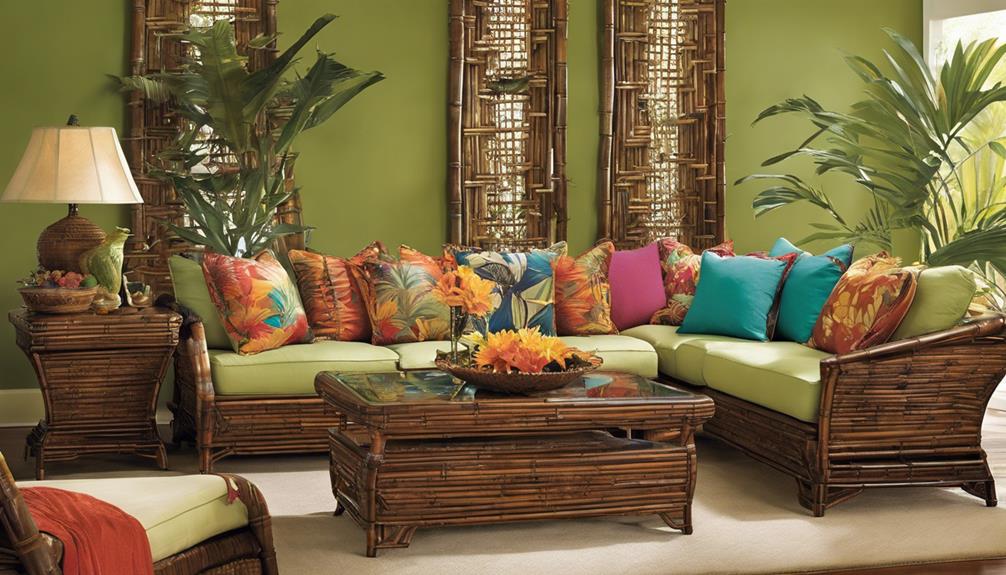
In the world of interior design, the lush greenery and vibrant colors of tropical style symbolize a retreat into nature and relaxation.
But what truly defines this design aesthetic? From patterns and prints to natural textures and materials, tropical design style encompasses a range of elements that evoke a sense of paradise within your home.
Let's explore how each element contributes to creating a space that transports you to a tropical oasis, inviting you to unwind and indulge in the beauty of your surroundings.
Key Takeaways
- Bold patterns and prints like palm motifs bring vibrancy and nature indoors.
- Incorporating greenery fosters tranquility and adds a lush tropical feel.
- Vibrant colors like turquoise and yellow create energizing and visually stimulating spaces.
- Natural textures such as rattan and bamboo enhance the tropical ambiance authentically.
Patterns and Prints
Incorporating bold and vibrant patterns inspired by nature is a key aspect of the tropical design style, instantly infusing spaces with a playful and exotic ambiance. Tropical walls adorned with palm tree motifs or banana leaves bring a touch of the tropics indoors. These natural materials, whether in wallpapers or textiles, add texture and depth to a room, creating a sense of lushness and vitality.
The use of palm prints on cushions or curtains can transport you to a sunny beach or a tropical forest, making you feel connected to nature even when indoors. The intricate details of these patterns mimic the beauty of the outdoors, allowing you to escape to a paradise of your own making. By incorporating these lively designs, you can transform any space into a vibrant tropical oasis, where the energy of nature flows freely. Embracing these bold prints is a sure way to inject life and personality into your home decor.
Greenery and Houseplants

Greenery and houseplants breathe life into tropical design, infusing spaces with lushness and vibrancy. These essential elements bring a touch of nature indoors, creating a tropical oasis. From towering palm trees to the sturdy snake plants, each addition regulates air quality while enhancing the aesthetic appeal. The variety of green plants used in tropical design not only refreshes the atmosphere but also evokes a sense of relaxation akin to tropical environments.
Incorporating houseplants of different sizes and shapes adds depth to the design, amplifying the tropical vibe within the space. The presence of greenery doesn't just contribute to the aesthetics but also fosters tranquility and a deeper connection to nature. The overall ambiance is elevated, making the space feel like a tropical paradise. By strategically placing these plants, one can achieve a harmonious balance between nature and interior design, resulting in a vibrant and inviting tropical setting.
Vibrant Tropical Colors
The lush greenery and houseplants in a tropical design effortlessly lead us into a vibrant world of tropical colors, including turquoise, aqua, green, yellow, and orange. These vibrant colors form the essence of a tropical palette, capturing the natural beauty of tropical environments with their dynamic and lively hues. To showcase the range and impact of these colors, let's explore a table highlighting their significance:
| Tropical Color | Description |
|---|---|
| Turquoise | Evokes the |
| crystal-clear | |
| waters of | |
| tropical beaches | |
| Aqua | Resembles the |
| refreshing | |
| tropical seas | |
| Green | Reflects the |
| lush foliage and | |
| jungles | |
| Yellow | Mimics the |
| bright sunshine | |
| of the tropics | |
| Orange | Symbolizes the |
| warmth and | |
| energy of | |
| tropical climates |
These vibrant tropical colors work harmoniously to create a visually stimulating and energizing tropical design style that transports us to a dynamic and lively oasis.
Natural Textures and Materials
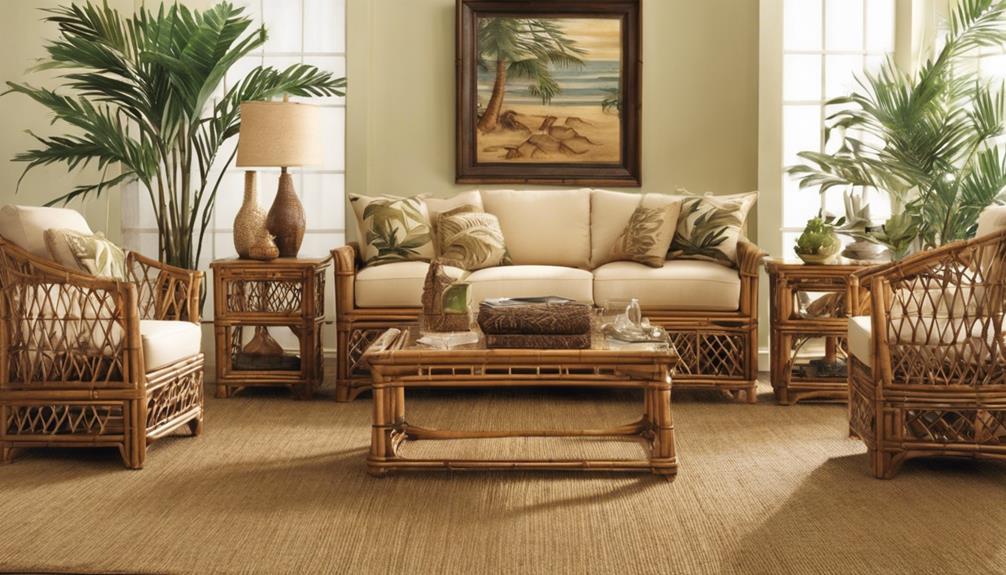
Enhancing the tropical ambiance, natural textures and materials like rattan, bamboo, and wicker infuse an authentic feel into the design space. These elements play a crucial role in creating a modern tropical interior that's both stylish and inviting. Here's how natural textures and materials contribute to the overall tropical design aesthetic:
- Organic Materials: Using materials like jute, seagrass, and teak helps to enhance the tropical vibe, bringing a touch of nature indoors.
- Natural Fibers: Incorporating natural fibers such as linen and cotton adds a light and breezy feel to the space, perfect for capturing the essence of a tropical paradise.
- Earthy Elements: Wood, stone, and water features not only add visual interest but also evoke a sense of the outdoors, promoting a connection with nature.
- Sustainability: Opting for sustainable materials like reclaimed wood and eco-friendly fabrics aligns with the tropical style's emphasis on natural living, promoting fresh air and a tranquil environment within the home.
Light and Airy Spaces
Creating an ambiance that feels light and airy is essential in tropical design style, achieved through strategic use of natural light and ventilation techniques. In tropical interiors, the emphasis is on harnessing the natural elements to create a sense of openness and spaciousness. Light-colored walls and furnishings play a crucial role in reflecting light and enhancing the overall brightness of the space. To maximize natural light, large windows, skylights, and glass doors are commonly incorporated, blurring the boundaries between indoor and outdoor areas. Additionally, light, sheer curtains or blinds are utilized to allow sunlight to filter through while maintaining privacy.
The use of lightweight fabrics, open shelving, and minimalistic furniture further contributes to the light and airy feel of tropical design style. These elements not only promote a breezy atmosphere but also evoke a sense of tranquility and relaxation. By embracing natural light and ventilation, tropical interiors create a welcoming and refreshing environment that invites a connection with the outdoors.
Frequently Asked Questions
What Are the Elements of Tropical Style?
When we think about tropical style, certain elements immediately come to mind. From vibrant colors that exude warmth to materials like wicker and rattan that invite a sense of relaxation, tropical design is all about blending indoors with the outdoors seamlessly.
Elements such as natural fabrics, pitched roofs for rain protection, and a focus on light and water all play a crucial role in defining this style that brings a touch of paradise into your home.
How to Design a Tropical Style?
When designing a tropical style, we focus on creating a lush and vibrant ambiance. Infusing bold patterns, green leaves, and natural textures is essential.
To achieve this, we incorporate elements like houseplants, rattan furniture, and colorful prints. By embracing the beauty of nature and incorporating personal style into decor choices, we can bring the tropical paradise indoors.
Let's transform our space into a relaxing oasis with vibrant hues and natural elements.
What Is Tropics Style?
When it comes to tropical style, we're talking about a design aesthetic inspired by the vibrant elements of nature like weather, sun, and water.
This style often blurs the lines between indoor and outdoor spaces, bringing in elements like pitched roofs and palapas for a seamless transition.
Think wicker, rattan, and natural fabrics like linen and cotton to create that laid-back, island vibe that defines tropical design.
What Materials Are Used in Tropical Interior Design?
When designing with a tropical vibe, we gravitate towards natural materials like wicker, bamboo, and teak to evoke that lush paradise feel. These elements infuse our spaces with warmth and relaxation.
Fabrics like linen and cotton enhance the airy ambiance, while seagrass rugs and sisal carpets bring in texture and earthy charm.
Plantation shutters made of wood or bamboo not only add a tropical touch but also allow us to control the light effortlessly.
Conclusion
In conclusion, the tropical design style brings a touch of paradise into your home with its vibrant colors, lush greenery, and natural textures.
Imagine lounging on a wicker chair surrounded by tropical prints and houseplants, basking in the warm glow of natural light.
The soothing ambiance created by these elements will transport you to a tropical oasis, where relaxation and creativity thrive.
Embrace the tropical design style to infuse your space with a sense of tranquility and exotic charm.
- About the Author
- Latest Posts
Introducing Ron, the home decor aficionado at ByRetreat, whose passion for creating beautiful and inviting spaces is at the heart of his work. With his deep knowledge of home decor and his innate sense of style, Ron brings a wealth of expertise and a keen eye for detail to the ByRetreat team.
Ron’s love for home decor goes beyond aesthetics; he understands that our surroundings play a significant role in our overall well-being and productivity. With this in mind, Ron is dedicated to transforming remote workspaces into havens of comfort, functionality, and beauty.
-

 Vetted3 weeks ago
Vetted3 weeks ago15 Best Contact Paper for Kitchen Cabinets to Elevate Your Home Decor
-

 Vetted1 week ago
Vetted1 week ago15 Best Poe Cameras for Home Security – Reviews & Buying Guide
-

 Vetted4 weeks ago
Vetted4 weeks ago15 Best Leather Restorer Products to Revive Your Furniture and Accessories
-

 Vetted3 weeks ago
Vetted3 weeks ago15 Best Drain Snakes to Unclog Your Pipes Like a Pro
-

 Beginners Guides9 hours ago
Beginners Guides9 hours agoI Inhaled Vinegar Fumes
-

 Vetted3 weeks ago
Vetted3 weeks ago14 Best Stationery Brands for Your Next Writing Adventure
-

 Beginners Guides2 weeks ago
Beginners Guides2 weeks agoSwinger Porch Light Color
-

 Mardi Gras Decoration3 weeks ago
Mardi Gras Decoration3 weeks agoWhy Does Hobby Lobby Not Do Mardi Gras?



















